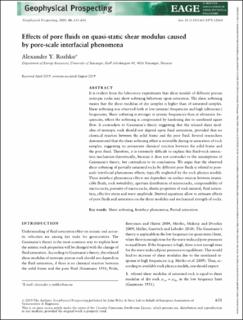| dc.description.abstract | It is evident from the laboratory experiments that shear moduli of different porous isotropic rocks may show softening behaviour upon saturation. The shear softening means that the shear modulus of dry samples is higher than of saturated samples. Shear softening was observed both at low (seismic) frequencies and high (ultrasonic) frequencies. Shear softening is stronger at seismic frequencies than at ultrasonic frequencies, where the softening is compensated by hardening due to unrelaxed squirt flow. It contradicts to Gassmann's theory suggesting that the relaxed shear modulus of isotropic rock should not depend upon fluid saturation, provided that no chemical reaction between the solid frame and the pore fluid. Several researchers demonstrated that the shear softening effect is reversible during re‐saturation of rock samples, suggesting no permanent chemical reaction between the solid frame and the pore fluid. Therefore, it is extremely difficult to explain this fluid‐rock interaction mechanism theoretically, because it does not contradict to the assumptions of Gassmann's theory, but contradicts to its conclusions. We argue that the observed shear softening of partially‐saturated rocks by different pore fluids is related to pore‐scale interfacial phenomena effects, typically neglected by the rock physics models. These interface phenomena effects are dependent on surface tension between immiscible fluids, rock wettability, aperture distribution of microcracks, compressibility of microcracks, porosity of microcracks, elastic properties of rock mineral, fluid saturation, effective stress and wave amplitude. Derived equations allow to estimate effects of pore fluids and saturation on the shear modulus and mechanical strength of rocks. | en_US |

